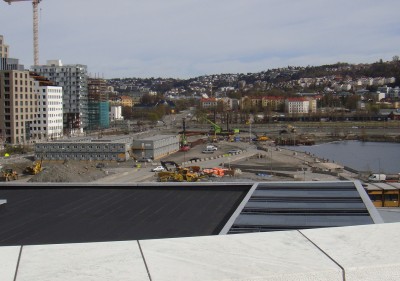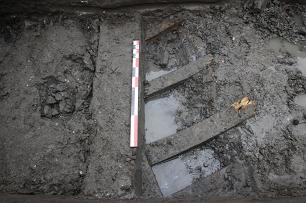The ongoing redevelopment of Oslo’s waterfront, along with several nearby highway and railroad improvement projects, has led to one of Norway’s biggest archaeological excavations ever. The treasures and knowledge that continue to be unearthed are reaching “epic” proportions, according to archaeologists involved.

On Monday came news of the discovery of a perfectly intact 23-carat gold ring with a precious stone, believed to be at least 700 years old. The ring stems from Queen Eufemia’s time in the 1300s.
Announcement of the discovery on Norwegian Broadcasting (NRK’s) morning newscasts comes just a day after newspaper Aftenposten reported that more skeletons had been found in the mud at Sørenga, an area of Oslo’s eastern harbour that’s now evolving into a new residential neighborhood with hundreds of apartments and condominiums. One of the skeletons found is believed to have belonged to a woman in her 60s who was killed by a severe blow to the head, and possibly decapitated as well, around 1,000 years ago. The questions that raises around why a woman of her age was murdered, and her head even possibly put on a stake, add mystery to history that literally was buried for centuries.
Archaeologists earlier have found the less-gruesome remains of around 20 ships and other small vessels dating back to the 1300-1600s. They have dug out timber from medieval buildings, pottery and porcelain, glass and other household objects, and canonballs. Newspaper Dagsavisen reported last summer how the excavations led by the Norwegian Maritime Museum have turned into one of the largest in history, in a country known for its excavations of nearly intact Viking ships. The discoveries mean a lot, not least for the University of Oslo (UiO) and its Museum of Cultural History, where the precious gold ring is already finding a home.

“I can’t recall such a ring ever being found in Oslo,” Marianne Vedeler, a professor of archaeology at UiO, told NRK. It was Line Hovd, an archaeologist at the Norwegian Institute for Cultural Heritage Research (NIKU), who literally struck gold while working at the site, and she called it a “once-in-a-lifetime” experience.
It was found during archaeological excavations that are underway before work starts on the new Follobanen railroad project, aimed at greatly improving commuter train service in and out of Oslo’s Central Station from the south and southeast. The trainline will run through some of the oldest areas of Oslo, Gamle Byen, which adjoin the Bjørvika area and already are home to ruins of churches and settlements from the Middle Ages. The archaeologists have been examining the area first, before building is allowed to proceed.
At the same time, archaeologists have been digging through the dirt where the new Munch Museum will rise at Bjørvika, next to the Opera House and in front of the so-called “Barcode” row of high-rises on land that also was excavated before construction began. “The excavations at Barcode just continue to give us things,” Hilde Vangstad, project leader and archaeologist at the Maritime Museum, told Dagsavisen.

Bjørvika was an important harbour in the Middle Ages, during the time when Oslo was under Danish rule and known as Christiania, and for the modern capital. It was a center for exports of timber and other products along with imports. Among items found, for example, was an intact beer jug from a brewery in the Netherlands. Settlements in the area have long pre-dated the Middle Ages. Not far away, on the hillside at Ekeberg, rock carvings known as helleristninger have been found that date back 3,000 years.
Vangstad said the discovery of many different types and sizes of vessels also “has given us much more knowledge about shipbuilding in Norway. It’s enormous.”
The digging continues in fenced-off areas that also have revealed old cobblestone streets buried under the mud and a Renaissance-era wharf. The Maritime Museum already has items on display and regularly posts updates of discoveries on placards placed along the fences. Developers are shouldering much of the cost of the escavations, which already have amounted to around NOK 100 million. The Maritime Museum also received an increase in state funding in the new state budget proposal for 2016 that was released last week.
newsinenglish.no/Nina Berglund

